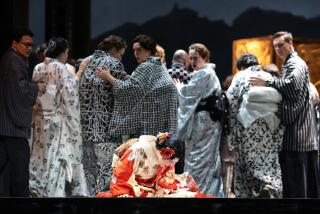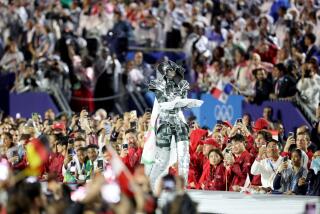Ornate but Unemotional
- Share via
You need a sense of humor, and history, to get through all three hours of the Paris Opera Ballet “La Bayadere.”
Except for its glorious vision of Nirvana (“The Kingdom of the Shades”), Marius Petipa’s 1877 dance spectacle is preposterous kitsch, a pseudo-exotic melodrama so devoid of dramatic, musical and even choreographic interest that the last act was chopped off early in the 20th century so that the ballet could end with its only authentic achievement: that “Shades” vision scene.
This truncated “Bayadere” is what Rudolf Nureyev learned and danced in Russia and restaged for the Paris Opera Ballet in 1992, shortly before his death. In contrast to his treatment of other, worthier Russian classics, he refrained from imposing any contemporary psychosexual interpretation on the plot or characters, but concentrated on restoring every Orientalist gaucherie in the original choreographic text as if it were high art.
On Tuesday, the Parisians danced the Nureyev “Bayadere” at the Orange County Performing Arts Center in an emotionally chilly performance stronger in ensemble virtues than star power.
As expected, “The Shades” inspired the women’s corps to mesmerizing stylistic purity, but conductor Vello Pahn (leading the Pacific Symphony) so emphasized speed and drive that the corps dancing unexpectedly acquired a distinctively windblown, will-of-the-wisp spirit here. Nirvana has never seemed so vibrantly alive.
To reach Nirvana, however, the audience must endure hours of hammy gesticulation, an overload of character dances that long ago lost any value as an evocation of the mystic East, and a plethora of silly staging details: Hindu tutus, a stuffed tiger as an index of heroism, stiff little parrot-dolls on the dancers’ hands, a huge, rolling elephant effigy--even a cadre of children in blackface.
No use pretending that the Petipa of “Swan Lake” and “Sleeping Beauty” is consistently on view in this earlier work, any more than the shabby tunes of Ludwig Minkus (reworked by John Lanchbery) match the Tchaikovsky or Glazunov ballet scores available to Petipa later in his career. Indeed, “La Bayadere” exposes the shallowness of 19th century Russian ballet traditions before their wondrous final flowering. Even if you believe that any antique is valuable, it’s no substitute for classical dance as a genuine art form.
Nor did the opening principals make you believe in it Tuesday. As Nikiya, the temple dancer who presides over rituals in this life and the next, Fanny Gaida wraps her long limbs into elegant body sculpture and delivers the steps efficiently, but lacks the molten pliancy and emotional force the role requires.
Similarly, the majestic Aurelie Dupont banks her fires as the regal, murderous Gamzatti and blunts her considerable technique in the betrothal scene with small insecurities and shaky terminations. Partnering both of them adroitly, the noble Manuel Legris makes an authoritative, accomplished Solor, though the freshest male bravura comes from Jeremie Belingard as a magnificently powerful Golden Idol.
The character is called the Bronze Idol in other productions, but the Paris version clearly has a bigger budget--and it shows, not only in the ornate costumes by Franca Squarciapino but in the elaborate architectural fantasies by set designer Ezio Frigerio.
Unfortunately, Frigerio’s imagination fails him in the “Shades” sequence, and the cramped, cluttered result is no match for the haunting designs by PierLuigi Samaritani for Natalia Makarova’s far more dramatically astute “Bayadere” for American Ballet Theatre and the Royal Ballet.
Paris offers brilliant ensemble dancing and everything money can buy, but Makarova had something greater: a true expressive vision and not just a vision scene.
* The Paris Opera Ballet dances “La Bayadere” with alternating casts on Friday and Saturday at 8 p.m. as well as Saturday and Sunday at 2 p.m. Orange County Performing Arts Center, 600 Town Center Drive, Costa Mesa. $20-$85. (714) 740-7878.
More to Read
The biggest entertainment stories
Get our big stories about Hollywood, film, television, music, arts, culture and more right in your inbox as soon as they publish.
You may occasionally receive promotional content from the Los Angeles Times.









